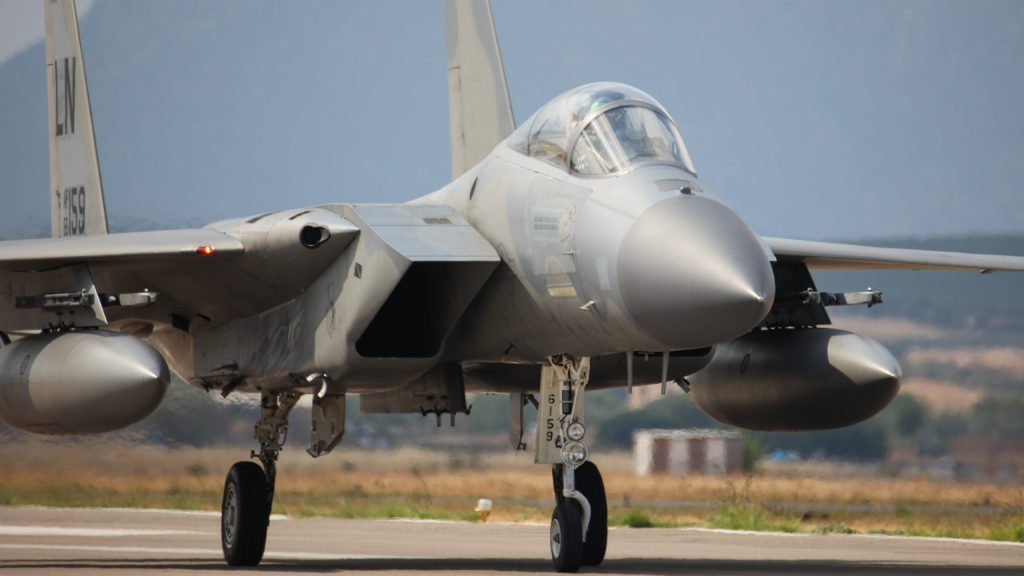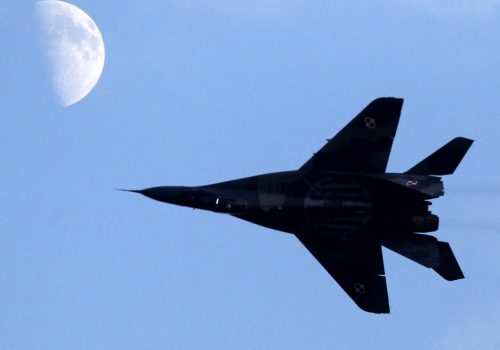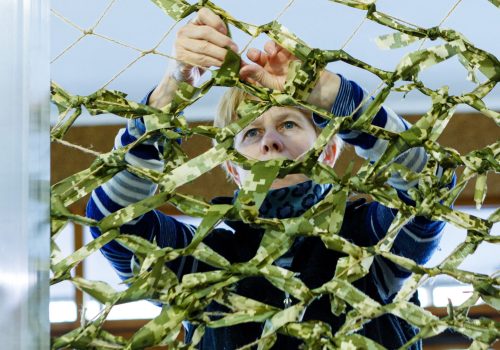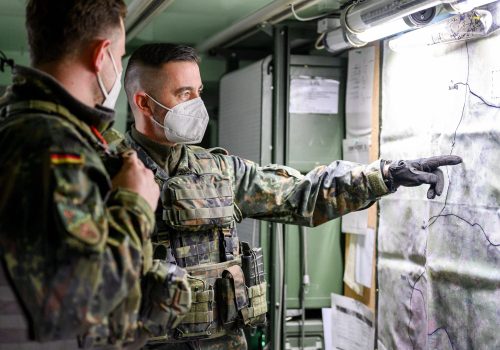As Russia’s military campaign in Ukraine grinds away, decimating cities and claiming more civilian lives each day, Western policymakers are grasping for ways to stop the killing. One of the major debates from Washington to Kyiv is whether the United States and NATO should impose a no-fly zone over Ukraine. In this series, Atlantic Council experts grapple with both sides of the controversial question, as well as offer other ways the West can help if, as seems likely at the moment, implementing a no-fly zone isn’t feasible. Below, Richard D. Hooker, Jr. argues in favor of a no-fly zone. Read Kelly Grieco’s case against one and Sarah Dawn Petrin and Marla Keenan’s proposal for other humanitarian interventions.
The Biden administration has cautioned that the United States will not enter the conflict in Ukraine. Its reasons are sound: War between nuclear powers has been a strategic third rail for decades. But the time has come to reconsider that approach.
It is now clear that Russian President Vladimir Putin’s ambition is to cement Russian control over wide swaths of the former Soviet Union. Should he succeed in Ukraine—as he did in Georgia, Crimea, and the Donbas—he is unlikely to stop. Continuous diplomacy and the relatively mild sanctions of 2014 signaled to him that the West lacks resolve. If Ukraine falls, NATO will face a new threat without the Ukrainian military on its side and with much less strategic depth. After all, it is only a short jump from Belarus to Kaliningrad, Russia’s Baltic enclave.
The choice is simple: We can confront Putin either now or later.
This is why the fastest and most effective support that NATO can offer Ukraine is a no-fly zone to keep Russian airpower out of play. Yes, Ukrainian resistance has been extraordinary so far. Frustrated by his military’s lack of progress, Putin is now bombarding cities and counting on terror to break the will of the Ukrainian people—whose fierce resistance has inspired the world. Sadly, though, despite the material assistance provided to Ukraine, Russia may well eventually prevail unless the West intervenes. A no-fly zone would enable NATO members to resupply Ukraine’s military by ground and air, as well as give Ukraine a realistic prospect of success and survival.
Critics have focused on the dangerously escalatory nature of such a move. Indeed a no-fly zone means suppressing enemy air defenses, and that some Western pilots and aircrew would be lost. But consider the alternative: After effectively swallowing Ukraine—potentially followed by Moldova—Russia might feel tempted to attack the Baltic states (all of which are NATO members). The Alliance would have no choice but to fight on the ground as well as in the air. The difference? By then, it would be pinned against the Baltic coast, with far less maneuver room and fewer forces, and against a Russian military flushed with success and massed in the field.
That war, like this one, will feature attacks on cities and high civilian casualties. Putin will have no moral currency left to lose.
So far, the Alliance has resisted calls for a no-fly zone. But the unprecedented unity shown by its members in recent days suggests that it might contemplate a rethink. High intensity, major-theater war has returned to Europe: Russian forces have even attacked the Zaporizhzhia Nuclear Power Station, the largest on the continent, while shocking images of civilian casualties—and even an attack near the Babi Yar Holocaust Memorial in Kyiv—have resonated across Europe.
Germany’s doubling-down on defense spending and its suspension of the Nord Stream II natural-gas pipeline represent a clear break with the pacifism and caution of the past. Meanwhile, traditional neutral countries Sweden, Finland, and Switzerland have all joined NATO in denouncing Russian aggression. The United Kingdom and Poland have reacted strongly with lethal aid as well as political and economic pressure, and even Russian apologists in Hungary and the Czech Republic have reversed course.
Europe has awakened. If NATO fails to achieve the unanimous consent needed to act on a no-fly zone, a coalition of the willing led by the United States—as civilian casualties and international condemnation continue to mount—might give Ukraine the fighting chance it needs to survive today, and forestall an even more bitter war tomorrow.
Fear of a military assault by Putin on NATO, or his use of nuclear weapons, remains strong. But in recent days, it has also become clear that Russia has already expended a significant part of its inventory of precision-guided munitions and ballistic missiles, while most of Russia’s conventional forces are committed inside Ukraine. The Russian military does not have much left to widen the war in any substantial way. Meanwhile, the arrival of significant US combat forces to NATO’s eastern flank already provides a hedge against this threat. As for Putin’s nuclear saber-rattling, the solid stability of nuclear deterrence over many decades should give us reassurance. NATO is a nuclear alliance for a reason, and the Russian leader knows he would risk massive retaliation.
Putin has gained much over the years by touting his “escalate to deescalate” doctrine. But if the West retreats every time he does so, it—and the world—will lose.
Entering the war in Ukraine is a sobering, painful, and difficult choice the West would prefer to avoid. But European security, so carefully constructed in the early 1990s, has collapsed. The West thought that 1939 could never happen again. Yet here we are, and as the Prussian military strategist Carl von Clausewitz reminds us, war changes things; cold policy calculations have their place. And so, too, does principle, and respect for the sovereignty of nations and the right of people to live in peace and freedom. Where the West’s interests and principles align, it should not fear to act. The window of opportunity is closing rapidly.
Powerful voices inside and out of government will continue to urge NATO to remain on the sidelines. “China First” advocates will argue that the United States lacks the strength to both confront Beijing and meaningfully intervene in Europe. The American far right, seduced by Putin’s authoritarian appeal, will protest. Diplomats will argue for more diplomacy, economists for more time to let sanctions work, and progressives for domestic priorities over foreign wars. Putin will continue rattling his nuclear saber, and many will be intimidated.
Yet that’s precisely why the West’s response must be different this time. It has allowed itself to be scared for far too long. Time grows short, and the alternative to action is grim and dangerous. Standing alone, Ukraine—for all its heroism and stoic endurance—may fall. The West stands at the crossroads. It is time to act.
Richard D. Hooker, Jr. is a nonresident senior fellow with the Atlantic Council. He previously served as special assistant to the president and senior director for Europe and Russia on the US National Security Council. He also served as dean of the NATO Defense College.
Further reading
Fri, Mar 18, 2022
A no-fly zone over Ukraine? The case against NATO doing it.
New Atlanticist By Kelly A. Grieco
Intervening beyond providing weapons to Ukraine's military and food to the Ukrainian population would only make the nightmare worse.
Fri, Mar 18, 2022
A no-fly zone over Ukraine? The case for NATO helping in other ways.
New Atlanticist By
There’s plenty NATO member states can do to protect civilians on the ground short of shooting down Russian aircraft.
Mon, Mar 7, 2022
A new era for NATO has begun
New Atlanticist By
On a political and on a military level, NATO is closer than ever—and readier than ever.
Image: A US F-15C Eagle fighter is seen during the Athens Flying Week 2021 air show in Tanagra Air Base in Greece on September 5, 2021. Photo by Nicolas Economou/NurPhoto/REUTERS



